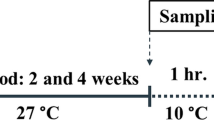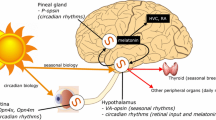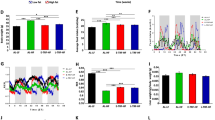Abstract
Many avian species reduce their body temperature (T b) to conserve energy during periods of inactivity, and we recently characterized how ambient temperature (T a) and nutritional stress interact with one another to influence physiologically controlled hypothermic responses in Japanese quail (Coturnix japonica). In the present study, we examined how the fatty acid (FA) composition of the diet influences the FA composition of phospholipids in major organs and how these affect controlled hypothermic responses and metabolic rates in fasted birds. For 5 weeks prior to fasting, quail were fed a standard diet and gavaged each morning with 0.7 ml of water (control), or a vegetable oil comprising saturated fatty acids (SFA; coconut oil), or unsaturated fatty acids (UFA; canola oil). Birds were then fasted for 4 days at a T a of 15°C. We found that, while fasting, both photophase and scotophase T b decreased significantly more in the SFA treatment group than in the control group; apparently the former down-regulated their T b set point. This deeper hypothermic response was correlated with changes in the phospholipid composition of the skeletal muscle and liver, which contained significantly more oleic acid (18:1) and less arachidonic acid (20:4), respectively. Our data imply that these two FAs may be associated with thermoregulation.





Similar content being viewed by others
References
Aronoff DM, Romanovsky AA (2007) Eicosanoids in non-febrile thermoregulation. Prog Brain Res 162:15–25
Austin JE (1993) Fatty-acid composition of fat depots in wintering canada geese. Wilson Bull 105:339–347
Bech C, Abe AS, Steffensen JF, Berger M, Bicudo J (1997) Torpor in three species of Brazilian hummingbirds under semi-natural conditions. Condor 99:780–788
Ben-Hamo M, Pinshow B, McCue MD, McWilliams SR, Bauchinger U (2010) Fasting triggers hypothermia, and ambient temperature modulates its depth in Japanese quail Coturnix japonica. Comp Biochem Physiol A 156:84–91
Beynen AC, Katan MB (1985) Why do poly-unsaturated fatty-acids lower serum-cholesterol. Am J Clin Nutr 42:560–563
Bizzi A, Garattin S, Veneroni E (1965) Action of salicylate in reducing plasma free fatty acids and its pharmacological consequences. Br J Pharmacol Chemother 25:187–196
Bligh EG, Dyer WJ (1959) A rapid method of total lipid extraction and purification. Can J Biochem Physiol 37:911–917
Brand MD, Couture P, Else PL, Withers KW, Hulbert AJ (1991) Evolution of energy-metabolism—proton permeability of the inner membrane of liver-mitochondria is greater in a mammal than in a reptile. Biochem J 275:81–86
Brigham RM, Kortner G, Maddocks TA, Geiser F (2000) Seasonal use of torpor by free-ranging Australian Owlet-Nightjars (Aegotheles cristatus). Physiol Biochem Zool 73:613–620
Calder WA, King JR (1974) Thermal and caloric relations of birds. In: Farner DS, King JR (eds) Avian biology. Academic Press, Nature, pp 259–413
Chen HY, Chiang SH (2005) Effect of dietary polyunsaturated/saturated fatty acid ratio on heat production and growth performance of chicks under different ambient temperature. Anim Feed Sci Tech 120:299–308
Crespo N, Esteve-Garcia E (2001) Dietary fatty acid profile modifies abdominal fat deposition in broiler chickens. Poult Sci 80:71–78
Else PL, Hulbert AJ (1987) Evolution of mammalian endothermic metabolism—leaky membranes as a source of heat. Am J Physiol 253:R1–R7
Else PL, Wu BJ (1999) What role for membranes in determining the higher sodium pump molecular activity of mammals compared to ectotherms? J Comp Physiol B 169:296–302
Falkenstein F, Kortner G, Watson K, Geiser F (2001) Dietary fats and body lipid composition in relation to hibernation in free-ranging echidnas. J Comp Physiol B 171:189–194
Fietz J, Tataruch F, Dausmann KH, Ganzhorn JU (2003) White adipose tissue composition in the free-ranging fat-tailed dwarf lemur (Cheirogaleus medius; Primates), a tropical hibernator. J Comp Physiol B 173:1–10
Fride E, Mechoulam R (1993) Pharmacological activity of the cannabinoid receptor agonist, anandamide, a brain constituent. Eur J Pharmacol 231:313–314
Geiser F, Firth BT, Seymour RS (1992) Polyunsaturated dietary lipids lower the selected body temperature of a lizard. J Comp Physiol B 162:1–4
Ginsberg BH, Jabour J, Spector AA (1982) Effect of alterations in membrane lipid unsaturation on the properties of the insulin-receptor of ehrlich ascites-cells. BBA-Biomembranes 690:157–164
Hill RW (1972) Determination of oxygen consumption by use of the paramagnetic oxygen analyzer. J Appl Physiol 33:261–263
Hohtola E, Hissa R, Pyornila A, Rintamaki H, Saarela S (1991) Nocturnal hypothermia in fasting Japanese quail: the effect of ambient temperature. Physiol Behav 49:563–567
Holtzman D, Lovell RA, Jaffe JH, Freedman DX (1969) 1-Δ9-tetrahydrocannabinol—neurochemical and behavioral effects in mouse. Science 163:1464–1467
Houslay MD (1985) Regulation of adenylate-cyclase (EC 4.6.1.1) activity by its lipid environment. P Nutr Soc 44:157–165
Houslay MD, Gordon LM (1983) The activity of adenylate-cyclase is regulated by the nature of its lipid environment. Curr Top Membr Trans 18:179–231
Houslay MD, Hesketh TR, Smith GA, Warren GB, Metcalfe JC (1976) Lipid environment of glucagon receptor regulates adenylate-cyclase activity. BBA-Biomembranes 436:495–504
Hulbert AJ (2008) The links between membrane composition, metabolic rate and lifespan. Alternate J 150:196–203
Jezierska B, Hazel JR, Gerking SD (1982) Lipid mobilization during starvation in the rainbow-trour, salmo-gairdneri richardson, with attention to fatty-acids. J Fish Biol 21:681–692
Jones PJH, Schoeller DA (1988) Polyunsaturated-saturated ratio of diet fat influences energy substrate utilization in the human. Metabolism 37:145–151
Lerner E, Shug AL, Chrago E, Elson C (1972) Reversible inhibition of adenine-nucleotide translocation by long-chain fatty acyl coenzyme a esters in liver-mitochondria of diabetic and hibernating animals. J Biol Chem 247:1513–1519
Locke RM, Rial E, Nicholls DG (1982a) The acute regulation of mitochondrial proton conductance in cells and mitochondria from the brown fat of cold-adapted and warm-adapted guinea-pigs. Eur J Biochem 129:381–387
Locke RM, Rial E, Scott ID, Nicholls DG (1982b) Fatty-acids as acute regulators of the proton conductance of hamster brown-fat mitochondria. Eur J Biochem 129:373–380
MacAvoy SE, Macko SA, Arneson LS (2005) Growth versus metabolic tissue replacement in mouse tissues determined by stable carbon and nitrogen isotope analysis. Can J Zool 83:631–641
McCue MD (2007) Snakes survive starvation by employing supply-and demand-side economic strategies. Zoology 110:318–327
McCue MD (2008a) Endogenous and environmental factors influence the dietary fractionation of C-13 and N-15 in hissing cockroaches Gromphadorhina portentosa. Physiol Biochem Zool 81:14–24
McCue MD (2008b) Fatty acid analyses may provide insight into the progression of starvation among squamate reptiles. Comp Biochem Physiol A 151:239–246
McCue MD, Amitai O, Khozin-Goldberg I, McWilliams SR, Pinshow B (2009) Effect of dietary fatty acid composition on fatty acid profiles of polar and neutral lipid tissue fractions in zebra finches, Taeniopygia guttata. Comp Biochem Physiol A 154:165–172
McKechnie AE, Lovegrove BG (2002) Avian facultative hypothermic responses: a review. Condor 104:705–724
McWilliams SR, Guglielmo C, Pierce B, Klaassen M (2004) Flying, fasting, and feeding in birds during migration: a nutritional and physiological ecology perspective. J Avian Biol 35:377–393
Mercer SW, Trayhurn P (1987) Effect of high-fat diets on energy-balance and thermogenesis in brown adipose-tissue of lean and genetically-obese ob/ob mice. J Nutr 117:2147–2153
Nagahuedi S, Popesku JT, Trudeau VL, Weber JM (2009) Mimicking the natural doping of migrant sandpipers in sedentary quails: effects of dietary n-3 fatty acids on muscle membranes and PPAR expression. J Exp Biol 212:1106–1114
Pan DA, Storlien LH (1993) Dietary lipid-profile is a determinant of tissue phospholipid fatty-acid composition and rate of weight-gain in rats. J Nutr 123:512–519
Pierce BJ, McWilliams SR (2005) Seasonal changes in composition of lipid stores in migratory birds: causes and consequences. Condor 107:269–279
Pierce BJ, McWllliams SR, Place AR, Huguenin MA (2004) Diet preferences for specific fatty acids and their effect on composition of fat reserves in migratory Red-eyed Vireos (Vireo olivaceous). Comp Biochem Physiol A 138:503–514
Piersma T, Bruinzeel L, Drent R, Kersten M, VanderMeer J, Wiersma P (1996) Variability in basal metabolic rate of a long-distance migrant shorebird (Red Knot, Calidris canutus) reflects shifts in organ sizes. Physiol Zool 69:191–217
Price ER, Guglielmo CG (2009) The effect of muscle phospholipid fatty acid composition on exercise performance: a direct test in the migratory white-throated sparrow (Zonotrichia albicollis). Am J Physiol 297:R775–R782
Rashotte ME, Basco PS, Henderson RP (1995) Daily cycle in body temperature, metabolic rate, and substrate utilization in pigeons: influence of amount and timing of food consumption. Physiol Behav 57:731–746
Satinoff E (1972) Salicylate—action on normal body temperature in rats. Science 176:532–533
Schleucher E (2004) Torpor in birds: taxonomy, energetics, and ecology. Physiol Biochem Zool 77:942–949
Schmidt-Nielsen K (1997) Animal physiology: adaptation and environment. Cambridge University Press, Cambridge
Shimomura Y, Tamura T, Suzuki M (1990) Less body-fat accumulation in rats fed a safflower oil diet than in rats fed a beef tallow diet. J Nutr 120:1291–1296
Shug A, Lerner E, Elson C, Shrago E (1971) Inhibition of adenine nucleotide translocase activity by oleoyl coa and its reversal in rat liver mitochondria. Biochem Biophys Res Commun 43:557–563
Smith WL, DeWitt DL, Garavito RM (2000) Cyclooxygenases: structural, cellular, and molecular biology. Annu Rev Biochem 69:145–182
Solomonovich A, Kaplanski J (1985) Effects of salicylate and indomethacin in nonfebrile rats at different ambient-temperatures. Prosta Leukotr Med 19:161–165
Stuart JA, Gillis TE, Ballantyne JS (1998) Remodeling of phospholipid fatty acids in mitochondrial membranes of estivating snails. Lipids 33:787–793
Sugiura T, Kondo S, Sukagawa A, Nakane S, Shinoda A, Itoh K, Yamashita A, Waku K (1995) 2-Arachidonoylgylcerol—a possible endogenous cannabinoid receptor-ligand in brain. Biochem Biophys Res Commun 215:89–97
Takeuchi H, Matsuo T, Tokuyama K, Shimomura Y, Suzuki M (1995) Diet-induced thermogenesis is lower in rats fed a lard diet than in those fed a high oleic-acid safflower oil diet, a safflower oil diet or a linseed oil diet. J Nutr 125:920–925
Trueman CN, McGill RAR, Guyard PH (2005) The effect of growth rate on tissue-diet isotopic spacing in rapidly growing animals. An experimental study with Atlantic salmon (Salmo salar). Rapid Commun Mass Spectrom 19:3239–3247
Valenti M, Vigano D, Casico MG, Rubino T, Steardo L, Parolaro D, Di Marzo V (2004) Differential diurnal variations of anandamide and 2-arachidonoyl-glycerol levels in rat brain. Cell Mol Life Sci 61:945–950
Walter I, Seebacher F (2009) Endothermy in birds: underlying molecular mechanisms. J Exp Biol 212:2328–2336
Weber TP, Piersma T (1996) Basal metabolic rate and the mass of tissues differing in metabolic scope: Migration-related covariation between individual knots Calidris canutus. J Avian Biol 27:215–224
Wojtczak L, Zaluska H (1967) Inhibition of translocation of adenine nucleotides through mitochondrial membranes by oleate. Biochem Biophys Res Commun 28:76–81
Acknowledgments
We are grateful to Shoshanna Didi-Cohen and Dr. Inna Khozin-Goldberg for help with GC analyses of fatty acid methyl esters. This project was funded by US–Israel Binational Science Foundation Grant 2005119 to B. Pinshow and S. R. McWilliams. During the study M.D. McCue was a Blaustein Postdoctoral Fellow and M. Ben-Hamo was the recipient of a Negev Fellowship. This study was done under the auspices of the animal care and ethics committee of Ben Gurion University. This is paper #697 of the Mitrani Department of Desert Ecology.
Author information
Authors and Affiliations
Corresponding author
Additional information
Communicated by H. V. Carey.
Rights and permissions
About this article
Cite this article
Ben-Hamo, M., McCue, M.D., McWilliams, S.R. et al. Dietary fatty acid composition influences tissue lipid profiles and regulation of body temperature in Japanese quail. J Comp Physiol B 181, 807–816 (2011). https://doi.org/10.1007/s00360-011-0558-2
Received:
Revised:
Accepted:
Published:
Issue Date:
DOI: https://doi.org/10.1007/s00360-011-0558-2




